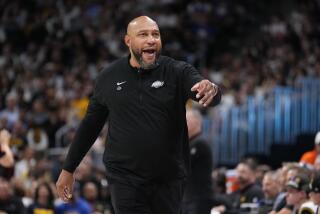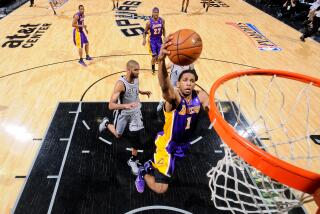Intangaroo has enchanted ties to life
This is a story about life, death, serious illness and a magic horse that seems to cure all.
The horse is named Intangaroo and she will run in Friday’s Filly and Mare Sprint for a $1-million purse in the Breeders’ Cup at Santa Anita.
She was purchased at the Keeneland sales in September 2006 for $37,000 and has won $623,231. Included in her five lifetime wins in 13 starts are three Grade I victories this year. Grade I is the rating given to the biggest races.
She didn’t get her first win until June 30, 2007, in a race at Hollywood Park that immediately followed Lava Man’s historic third straight victory in the Hollywood Gold Cup. On that day, Intangaroo was hardly noticed.
Even if she never raced again, she would have remained forever in the minds and hearts of the family of Tom Grether, longtime horse owner. His son, Carl, a lemon farmer from Somis, near Ventura, owned Intangaroo and had stopped to visit his ailing father three days before the race. Tom Grether was 80 and seriously ill with Parkinson’s disease.
“I told him I had a horse running that weekend,” Carl says. “He told me he wanted to bet on her. He gave me $400. He usually bet across the board [a third to win, a third to place and a third to show]. Not this time. He said bet it all to win.”
The next day, Tom Grether collapsed, went into a coma and was quickly put on a life-support system. The family gathered for the terrible decision, waited for Intangaroo to break her maiden, made the decision to turn off the life support and soon was preparing Tom Grether for his funeral. “We got him in his best suit,” Carl says, “and tucked the winning ticket on Intangaroo in his pocket.”
For Intangaroo, after a year of injury and undistinguished performances, there was new racing life. Directing that was a trainer named Gary Sherlock, who had been a fixture around racetracks in Southern California since the 1960s and who, like Intangaroo, had been relatively undistinguished.
Sherlock had purchased Intangaroo for Carl Grether. It had been Sherlock’s first push back into race training after a winding path that had taken him from great success as a quarter-horse trainer at Los Alamitos in the Wayne Lukas era to several years when he stayed away from the track completely.
“The night racing at Los Alamitos finally got to me,” he says now. “I wanted to see my two boys grow up, see their baseball games, and I did.”
And then, one day in 1995, the pain in his head began.
“It was like a hatchet stuck in my face,” he says.
Sherlock had a blocked artery in his brain, such a severe ailment, with surgery not possible and blood thinners the only treatment, that doctors told him that only one in four survive it.
“I said to the doctor, ‘I’m pretty good with odds,’ ” Sherlock says. “That means a 75% chance that I don’t make it. The doctor nodded.”
Sherlock had no insurance. His wife had quit her job 30 days before at, of all places, an insurance agency.
“That could have been a disaster,” he says, “but they really couldn’t do anything, anyway, so there wasn’t much cost after the first 10 days I was in the hospital.”
Sherlock’s treatment was to wait and hope. The only instruction from doctors to his wife was to keep him away from horses and horse racing. No worry there.
“I spent four months in my bedroom,” he says. “I never left. I slept through it, even though the pain never stopped. I slept with my face down on the side where the pain was.”
Sherlock was one of the lucky 25%. When he got back on his feet, a friend in the insurance business hired him to get him medical coverage. That turned into a business back at the track, where Sherlock helped devise workers’ comp plans for track personnel for most of the next 10 years.
He always dabbled in buying and selling horses, and by 2006 he was ready to make a comeback in the training business. That started with his trip to Keeneland and his purchase of six horses, one of them Intangaroo.
Which brings this story to the afternoon of Feb. 2 of this year. Sherlock thought that the Grade I Santa Monica Handicap at Santa Anita would be a nice showcase for the still-unheralded Intangaroo.
“I looked at the field,” he says, “and I wanted to get her some graded money winnings, because that would increase her value. I was looking for maybe a third place, just anything in the money.”
Instead, Intangaroo, off at 26-1 odds, beat Society Hostess by a nose, and life had changed for Sherlock and Carl Grether. A new plan was designed, Intangaroo was trained to be at top form for the remaining Grade I sprints for fillies and mares that prepped for the Breeders’ Cup, and the plan worked perfectly.
She won the Humana Distaff on May 8, Kentucky Derby day at Churchill Downs, beating a great competitor and the defending champion, Hysterical Lady. Then she won the Ballerina at Saratoga on Aug. 28.
There are four Grade I sprints scheduled each season for fillies and mares. Intangaroo has won three of them, each at the same seven-furlong distance of Friday’s race.
Sherlock thinks Intangaroo should be the favorite Friday, even though last year’s Breeders’ Cup Juvenile Fillies champion, Bob Baffert’s Indian Blessing, is a likely starter.
Mostly, Sherlock is grateful for the ride.
“She’s a gift,” he says.
Carl Grether says it differently.
“When the horse runs,” he says, “I don’t even get nervous anymore. And I know my dad is somewhere, watching.”
--
More to Read
Get our high school sports newsletter
Prep Rally is devoted to the SoCal high school sports experience, bringing you scores, stories and a behind-the-scenes look at what makes prep sports so popular.
You may occasionally receive promotional content from the Los Angeles Times.







